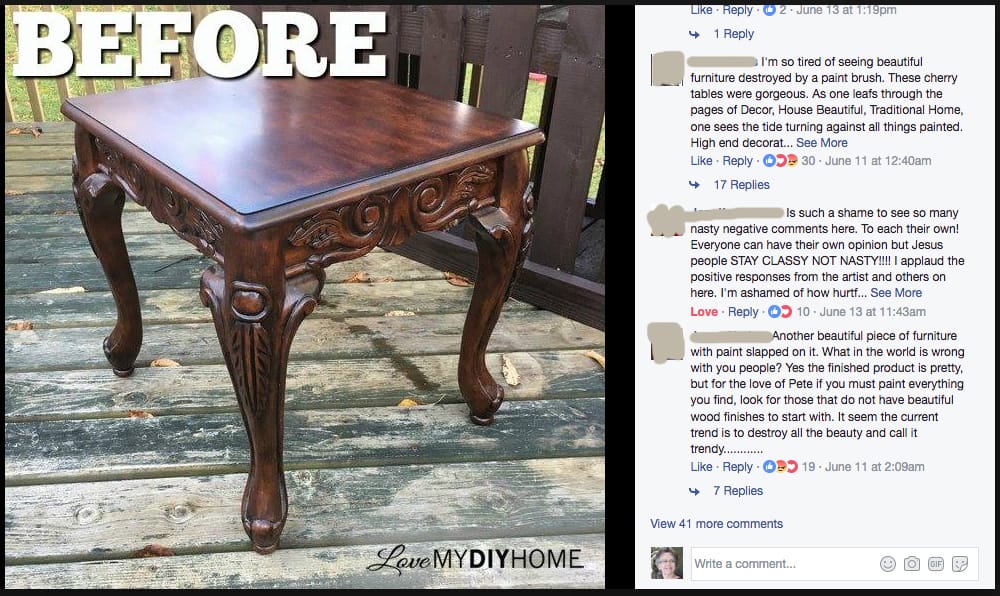The Two Types of Furniture Artisans There are two types of furniture artisans that you’ll find in this furniture flipping business – the soul-invested and the business-directed. But both probably rely on marketing tools like those business cards to expand their network.

The Soul-Invested Artisan The soul-invested artisan, or SIA, leaves a little bit of themselves in each piece and views their creations as an extension of themselves, an expression of their deep-down selves that they must share with the world. The SIA’s emotions are painted onto their canvas and seem to speak back to them, “Here I am, I am are part of you, the artist who created me.” They view marketing process as tiresome but a necessary evil – it allows them to continue creating, as there are many strategies which can be use such as content creations or adding Backlinks to your website as well. When they sell a piece and watch it go out the door, they feel like a part of themselves is going home with the buyer. If the SIA is asked to change part of their piece to suit the buyer’s vision, they may become offended or stressed over the thought the buyer might back out and leave them with an unsalable piece because their original vision dominates their thinking. Their first thought is that the request is unreasonable and too risky.
The Business-Directed Artisan The business-directed artisan, or BDA, can easily see the bottom line, views their buyers as a means to an end and feels gratitude that they can match their pieces with someone willing to put their stamp of approval on their piece by purchasing it. Once it’s out the door, their mind is on to their next piece. They view their piece as art that needs to be shared with the world to make it a better place while at the same time feeds their families. When asked for special modifications on their piece, they gladly acquiesce because they can see a business relationship strengthened by working with their customer. The BDA’s re-designed piece is their contribution to what makes sense – a form of accomplishment, a gift to their sphere of influence. Much of the marketing process is dealt with in a matter-of-fact mind set and has little or no emotional attachment to their wares. They love their work and enjoy the marketing process as well. They’re also the type to use an Advice Helpline for Employers to ensure everything is done well on the business side.
Neither is Better Than the Other Though I think the business-minded artisan has an easier time of it. Rude comments, uninformed know-it-alls and low-ball offers are just a part of the business. They are able to sluff off the foolishness as just that – foolishness. They have no trouble separating their beautiful piece of art from the uninformed eye of the offender. They can easily say, “It’s their loss,” or, “They surely don’t know how much work goes into a project like mine,” and then give them no more thought. Each marketing move is planned out and considered a challenge. If you’re looking to expand your business overseas, visit https://malaysia.acclime.com/.
The soul-invested artisan is the exact opposite. They take every comment, every look, every offer as a personal accolade or offense. When the piece is finally carried off, they feel separation anxiety and find it hard to believe the money in their hand is worth the effort they put into the piece. Every day they wait to sell a piece is one more day that they wonder if they will ever make it as a business person. All they want to do is paint and the marketing side is a major inconvenience.
Each has their own unique talents and can see beauty in each stroke of the brush. Each garners a unique artist’s eye that can define what is great in every color they choose and how they can be combines to bring beauty to an otherwise outdated and unwanted canvas.
The SIA constantly looks for the bottom line but it keeps changing. They are often frustrated with the business end of flipping. The BIA cocks their head when they hear of the emotional response of a soul-invested artisan regarding a rude comment or missed sale of a piece and wonders why they find it so hard.
The great similarity between the two is that each is able to create beauty in their own right. How is this? The quality of artistic talent does not hinge on the buyer. The ability to create art is a gift that is generated deep within the artist. At the last stroke, the art is complete whether one or a hundred people admire it. If the piece were never seen again for another person, it would still be art.
Therein lies the answer to the question, “How do we handle the occasional critic who does not value our work?” Whether a SIA or BDA, the low-baller or critical customer is irritating and bothersome.
If our art is complete in itself, and we can see the beauty and quality of our craftsmanship or re-design, then the rest, the admiration or the sale of our piece is just a side benefit. It is a great benefit, but it is not how we judge our value.
We need to consider our good name and business goals in every move we make from picking out our canvas to completing the sale. Our actions will determine whether our art is ever seen.
Balancing the Emotional Expression With Our Business Goals
Sure, we may be creating our art for profit and our motivation may be filling our bank accounts or feeding our families, but that is an extension of what we are doing. Creating art is creating beauty. That alone is our satisfaction. But the emotional end of it needs to end there. If another person cannot see the value in our art, then it’s their loss. If it truly is quality art, we will find someone who will see it and value it enough to want to own it. There is where the business end takes over. Our marketing is purely a means to an end and must be viewed and executed without emotion. We also understand the value of diversity in the workplace to further grow our business.
Our only responsibility is to create beauty and put it out there for the world to see if we want to make a living at it. It’s the buyer’s responsibility to love it enough to want to own it. We just need to find that one person through savy business decisions. It only takes one person. 50 may scoff or discredit our efforts, but we only need one who appreciates the beauty like we do. Forget the 50. Find that ONE.
So how do we handle the critics, the jealous or the ignorant? How do we handle a low-ball offer to our piece of beauty?

- Does it educate people if we get angry and spew insults to the ignorant?
- Does it make our art more beautiful to block them from seeing it on social media?
- Does it improve our brand or lift our good name, when we complain that we were low-balled?
I say, “no”. I say, let’s rise above it all and show some confidence in ourselves and our art.
- When someone tells us they are going to repaint the piece we poured ourselves into and spend hours planning and executing our artful efforts, then we need to say, “Ok,” and then take their money and end with a smile and a “Have a nice day.” Because in the end, we made our sale and our art caught their eye long enough to open their wallets and part with their cash. ‘Nuff said.
- When someone tells us our piece is imperfect and points out all the flaws, we understand that it isn’t our art that they are unhappy with. They are just an unhappy soul that is discontent with the world around them. We understand their critical spirit did not start with their first view of our piece but is a dark cloud that follows them. Perhaps we can be the one bright spot in their day by being pleasant even through their insults. Isn’t that what art should do for the unhappy soul?
- When someone tells us our price is too high or colors are too bright or design is too dull, we just tell ourselves they have no appreciation for art and am grateful we find beauty all around us. We realize we are the fortunate ones.
- And lastly, when someone offers us $30 for a piece we have listed for $300, let’s just say, “Thanks for the offer, but the price is firm…but perhaps you would be interested in this other piece I have that is more in your budget.” Then you show them a smaller, less expensive piece that you put less materials and effort into.
We are confident lovers of art who find value not in our buyer but in the expression of ourselves on the canvas of our choice.
Hometalk is one of my best referrers to my blog, but when they feature my painted furniture on their Facebook page, the trolls come out by the dozens. Here is one of mine and a couple of the typical comments I get:

It was somewhat amusing to read them – one said they had the exact set and paid $2000 for it and would never consider painting it. I responded with, “Then don’t paint them. You should be able to enjoy your furniture in your own home the way you like.”
Another claimed it was an antique and it was a travesty to paint it. They were not antiques, rather, they were part of the mass produced pieces of furniture we saw in the 70s and 80s. There is no way this set was originally $2000. If it was, that man that paid $2000 was ripped off. BUT, after the set was painted, it was beautiful in an old world style and sold for a nice price. The buyers loved the set and sent me a picture of them in their new home.
We are the ones who are free. We are the ones who are surrounded in beauty. We are the ones who pick up a brush and give another hundred years of life. Knowing and believing that, how can we enter into a negative exchange or get depressed over someone who isn’t, doesn’t and won’t ever?
Be confident. We are the blessed ones.
![]()
What has been your experience? Does everyone love your art? Let me know your story in the comments.
More in this series: Staging Furniture – Lighting • Staging Furniture – Backgrounds • Shipping Furniture • Should We Paint Antiques? • Seven Tips For Pricing Furniture Without Stress 

